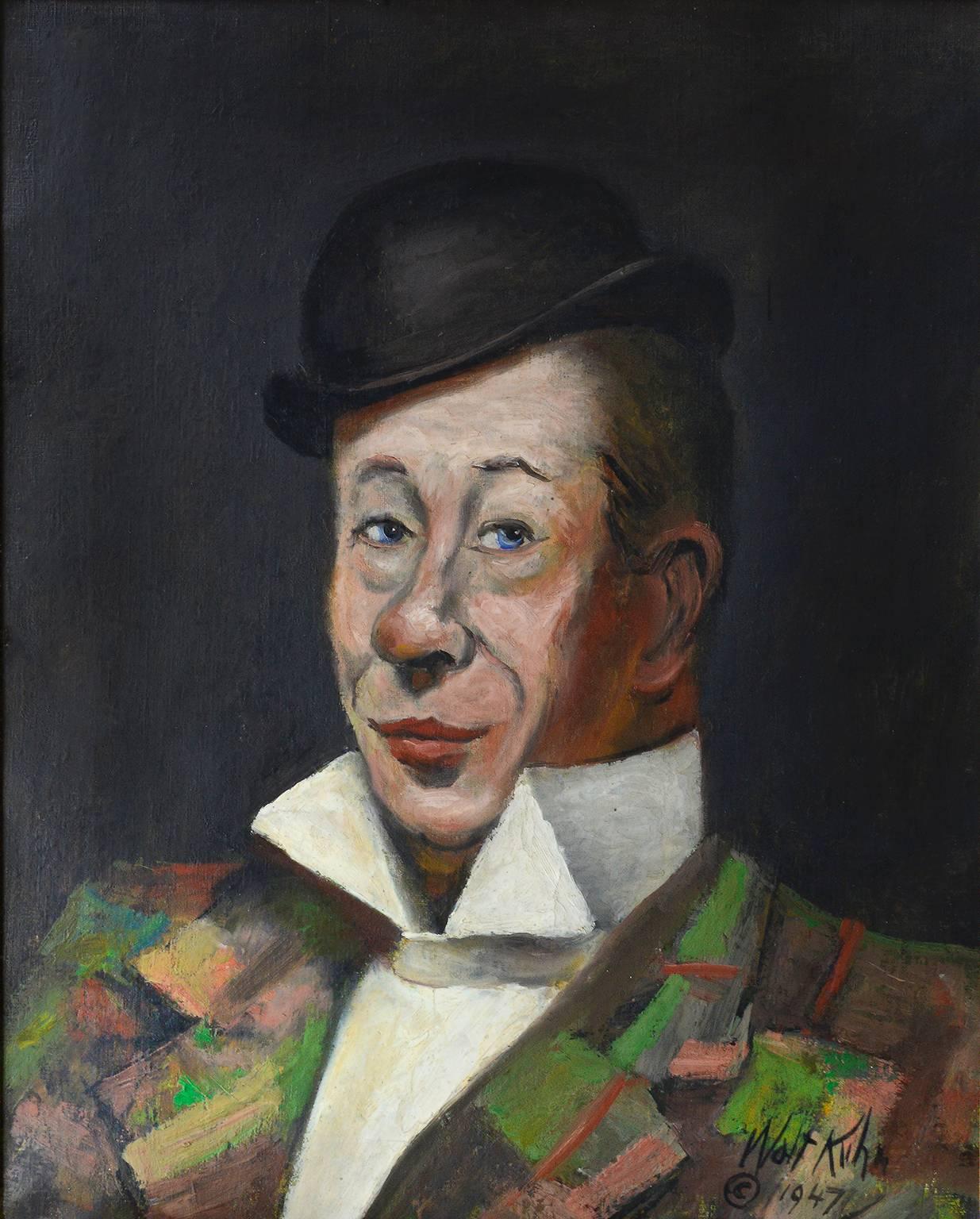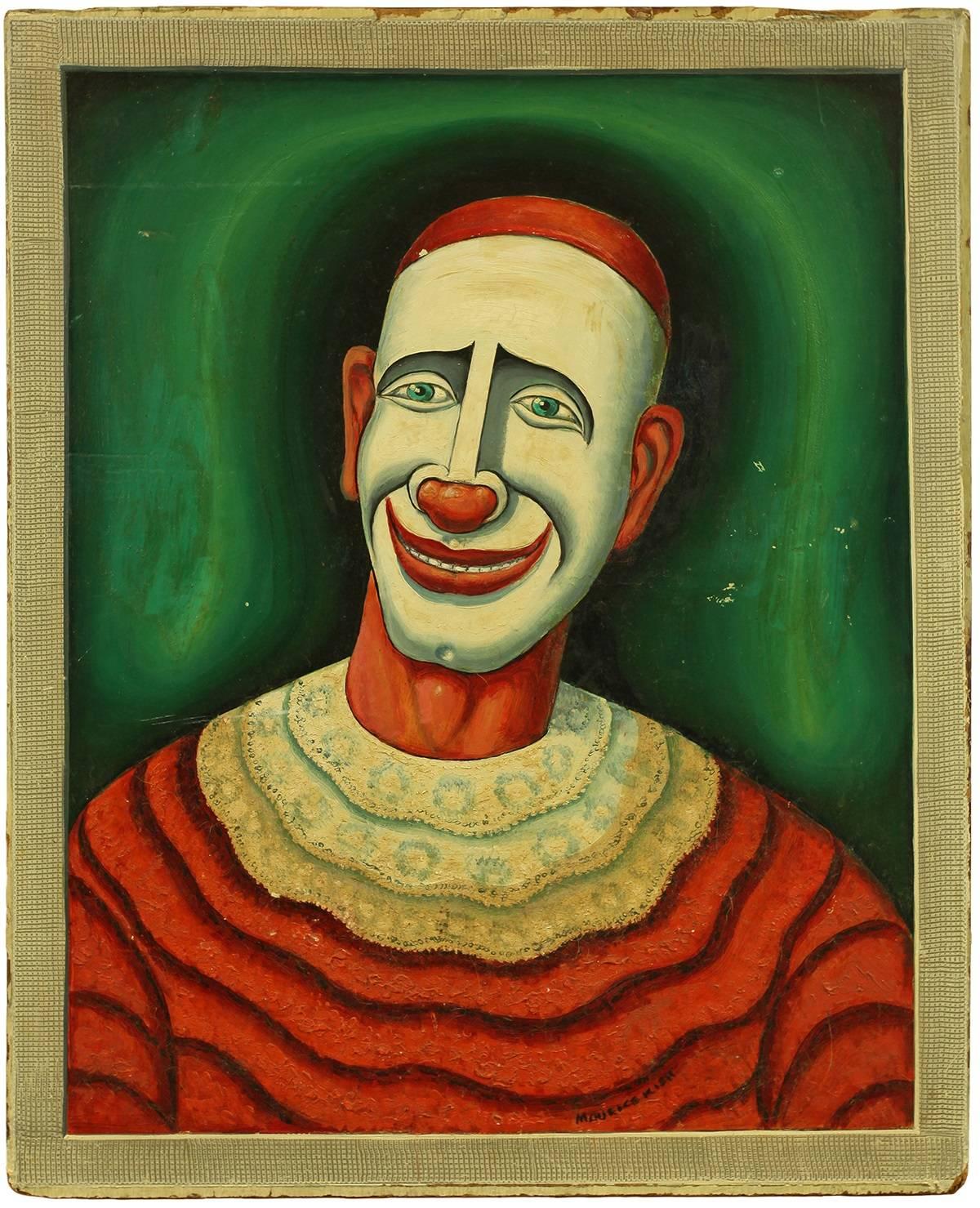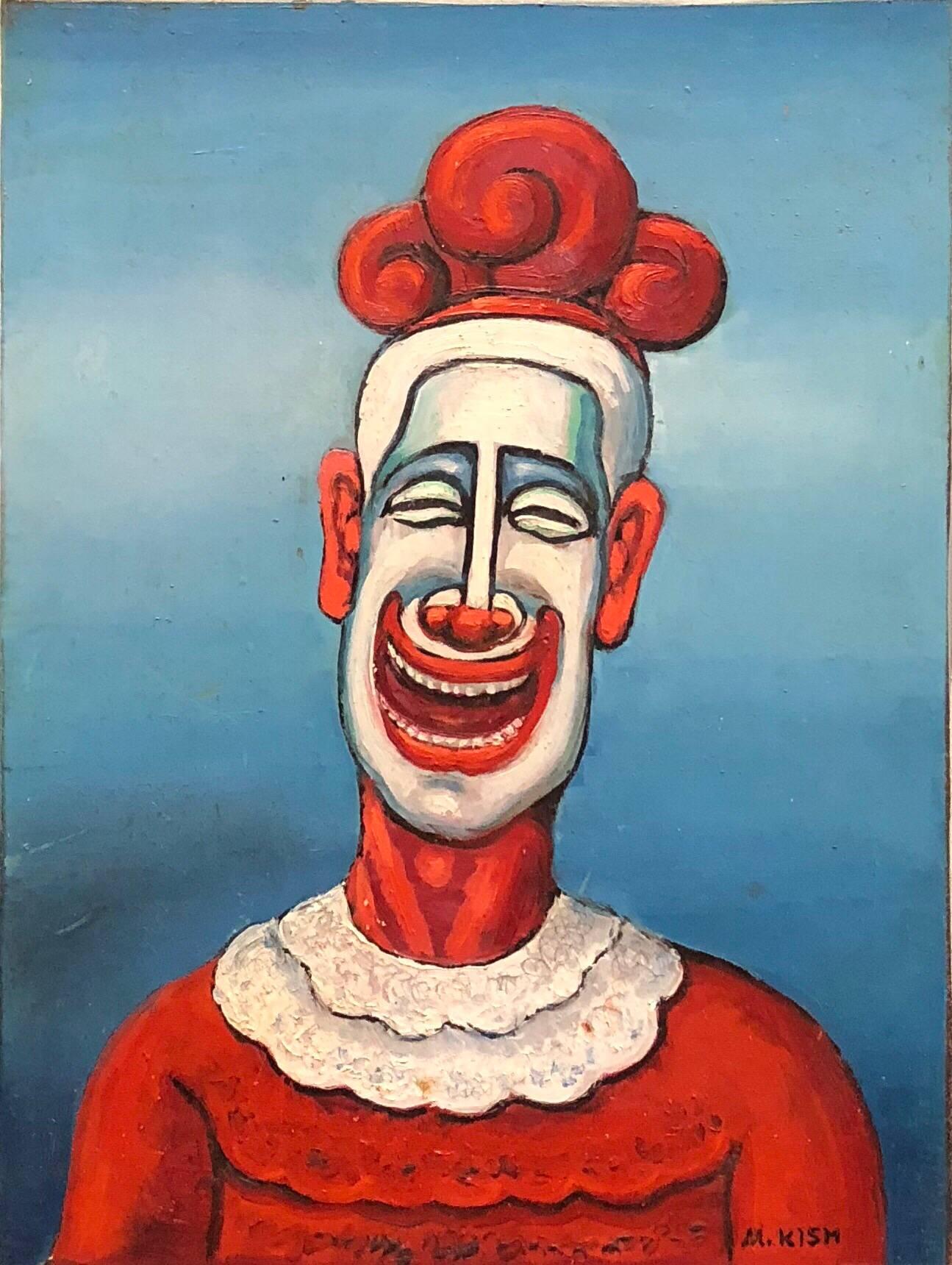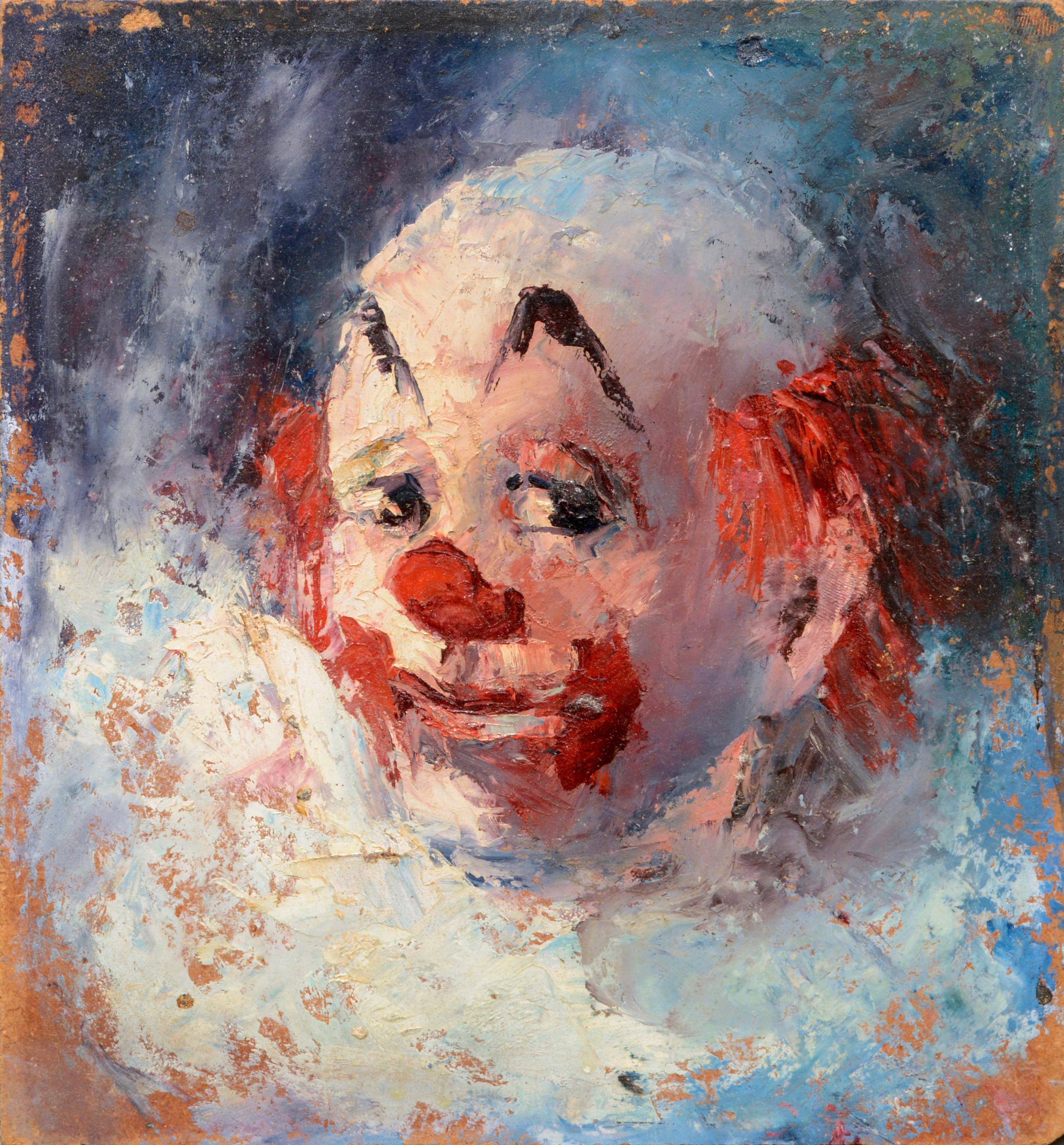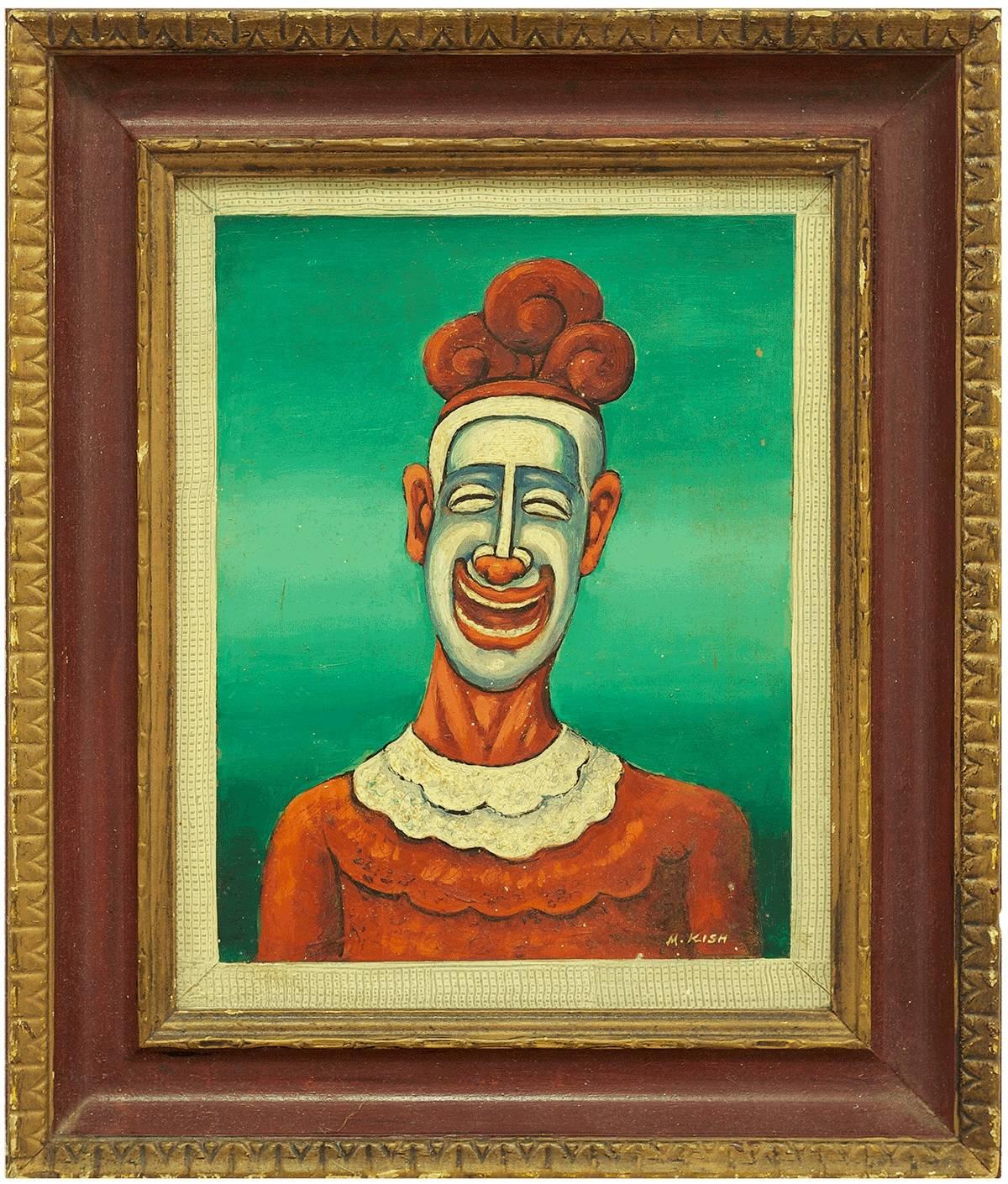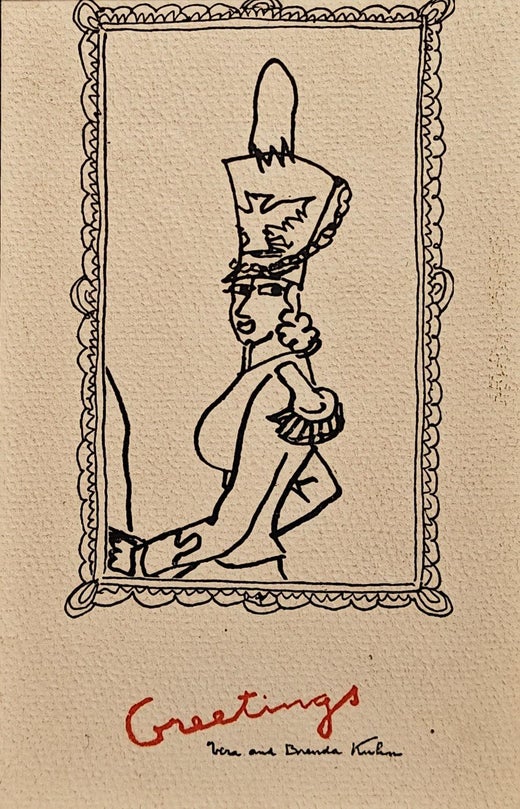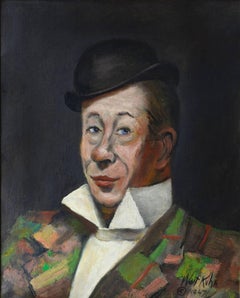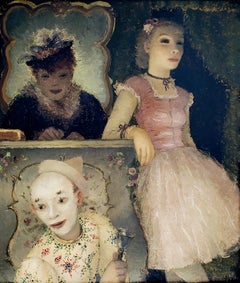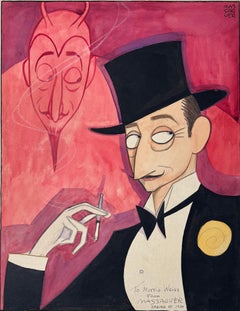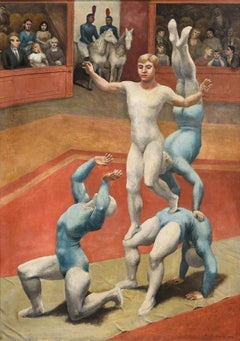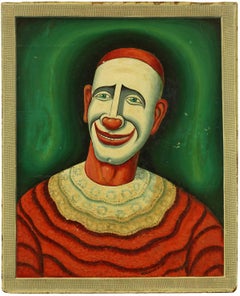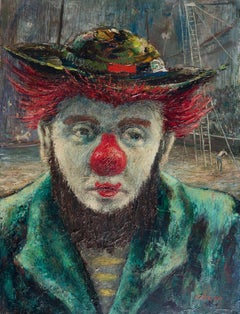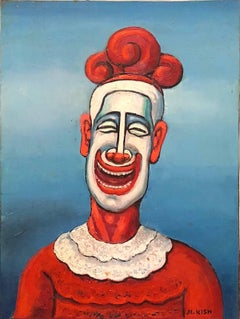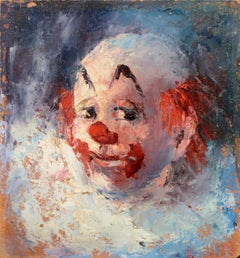Items Similar to Portrait of Bert Lahr - Circus Performer - Modernism
Want more images or videos?
Request additional images or videos from the seller
1 of 13
Walt KuhnPortrait of Bert Lahr - Circus Performer - Modernism1947
1947
$145,000
£107,855.48
€126,277.46
CA$202,324.24
A$226,406.50
CHF 118,218.84
MX$2,783,432.30
NOK 1,491,466.93
SEK 1,403,463.03
DKK 942,126.70
Shipping
Retrieving quote...The 1stDibs Promise:
Authenticity Guarantee,
Money-Back Guarantee,
24-Hour Cancellation
About the Item
A recent Kuhn Circus Performer sold for $312,000 at Bonhams, NY
Bert Lahr shined in the role of The Cowardly Lion in the Wizard of OZ. Here he is depicted in his comdian's costume which he wears while staring in Jean Dalrymple's production of " Burlesque". Walt Kuhn was an American painter and an organizer of the famous Armory Show of 1913, which was America's first large-scale introduction to European Modernism. He had a personal affinity for painting circus performers
Provenace: Sotheby's, New York
Barridoff Galleries
Kennedy Galleries
Amon Carter Museum
University of Arizona Art Gallery
- Creator:Walt Kuhn (1877-1949, American)
- Creation Year:1947
- Dimensions:Height: 20 in (50.8 cm)Width: 16 in (40.64 cm)
- Medium:
- Movement & Style:
- Period:
- Condition:slight stretcher marks otherwise presents well.
- Gallery Location:Miami, FL
- Reference Number:1stDibs: LU38532838421
Walt Kuhn
Walt Kuhn (1877-1949) He was associated with "The Eight" and with Arthur B. Davies, was a the key figure in forming the American Association of painters and Sculptors that organized the Armory Show of 1913 that introduced modernist European art to America. Kuhn was executive secretary of the Association and traveled abroad to select entries for the Armory Show. He was strongly influenced by Cezanne which is evident in many of his paintings. Like Cezanne, he destroyed many of his paintings, keeping only about a dozen a year. He was born in Brooklyn, New York and in 1900 first used the name Walt when illustrating magazines in San Francisco. He studied at the Royal Academy in Munich from 1901 to 1903 and returned to New York where he worked as a cartoonist and magazine illustrator. In the permanent collection of most major museums worldwide. His record price for a painting to date is 1.6 Million dollars.

About the Seller
4.9
Vetted Professional Seller
Every seller passes strict standards for authenticity and reliability
Established in 2005
1stDibs seller since 2016
115 sales on 1stDibs
Typical response time: <1 hour
- ShippingRetrieving quote...Shipping from: Miami, FL
- Return Policy
Authenticity Guarantee
In the unlikely event there’s an issue with an item’s authenticity, contact us within 1 year for a full refund. DetailsMoney-Back Guarantee
If your item is not as described, is damaged in transit, or does not arrive, contact us within 7 days for a full refund. Details24-Hour Cancellation
You have a 24-hour grace period in which to reconsider your purchase, with no questions asked.Vetted Professional Sellers
Our world-class sellers must adhere to strict standards for service and quality, maintaining the integrity of our listings.Price-Match Guarantee
If you find that a seller listed the same item for a lower price elsewhere, we’ll match it.Trusted Global Delivery
Our best-in-class carrier network provides specialized shipping options worldwide, including custom delivery.More From This Seller
View AllPortrait of Bert Lahr as Burlesque Clown - The Cowardly Lion in the Wizard of Oz
By Walt Kuhn
Located in Miami, FL
Burlesque Clown Bert Lahr is dipicted in a bowler hat with a wry grin. Lahr shined in the role of The Cowardly Lion in the Wizard of OZ. Here he is de...
Category
1940s American Impressionist Portrait Paintings
Materials
Oil
Ballerina, Clown and Festival Performers - like Edgar Degas
By Dietz Edzard
Located in Miami, FL
It is a work by Edgar Degas? A stunning and beautiful study of three members of a fair in an off moment. Dramatic underlighting creates a dramatic mood. Deftly rendered in the ...
Category
1930s Post-Impressionist Portrait Paintings
Materials
Oil
$28,000 Sale Price
20% Off
Cuban Artist - Caricature of Adolphe Menjou Debonair Devil
Located in Miami, FL
Framed Cuban Artist/Caricaturist Conrado Walter Massaguer presents Hollywood star Adolphe Menjou in a satirical dual portrait. In the foreground, the subject is seen in a dapper top hat, tux, fashionable cigarette and boutonnière, and is shown as being the epitome of being stylishly debonair. To make a larger point about this subject, Massaguer paints a cast shadow of Menjou as a burning red devil who studies his alter ego from above. Keeping with the artist's sarcasm, we see the good and bad in one image. Works by Massaguer are rare and this work is in keeping with his signature style. This work was most likely done on assignment for Life Magazine, Cosmopolitan, The New Yorker or Vanity Fair. Signed upper right. Inscribe lower right. Titled on verso. Unframed, Slight bend to board; toning to board; scattered faint foxing; pin point abrasions to margins, not affecting image. 19-1/2 x 15-1/8 inches board size.
Conrado Walter Massaguer y Diaz was a Cuban artist, political satirist, and magazine publisher. He is considered a student of the Art Nouveau. He was the first caricaturist in the world to broadcast his art on television.He was first caricaturist to exhibit on Fifth Avenue. He was the first caricaturist in the world to exhibit his caricatures on wood. He, and his brother Oscar, were the first magazine publishers in the world to use photolithographic printing.
Self portrait of Conrado Walter Massaguer, depicted on a carrousel ride, with the devil over his left shoulder and an angel over his right. (1945)
He created the magazine Social with his brother Oscar to showcase Cuban artistic talent. The duo later created the magazine Carteles, which became for a period the most popular magazine in Cuba, which was purchased by Miguel Ángel Quevedo in 1953.
In his life, he met and drew caricatures of Franklin D. Roosevelt, Walt Disney, Albert Einstein, the King of Spain, and many others.[ In sum total, he was the author of more than 28 thousand caricatures and drawings.Ernest Hemingway once had to refrain himself from punching Massaguer in the face after the artist drew an unflattering caricature of him. The dictator Gerardo Machado, however, did not punch Massaguer for his own unflattering caricature - he had the artist deported.
He was one of the most internationally renowned Cuban artists of his day, and his art is still regularly featured in galleries across the Western Hemisphere and Europe.
Early life
Massaguer was born on October 18, 1889, in Cárdenas, Cuba.[In 1892, his family moved to Havana.
When the Cuban War of Independence broke out, Massaguer's family escaped the country. From 1896 to 1908, he lived in Mérida, Mexico. However, during this time, his parents enrolled him in the New York Military Academy, where he stayed during school years.
In 1905, after graduating the military academy, he briefly attended the San Fernando school in Havana, where he was tutored by Ricardo de la Torriente and Leopoldo Romañach.
In 1906, less than a year later, he returned to the family home in Mexico.
Career as artist
Early career
While living in Yucatán, Mexico, Massaguer published his first caricatures in local newspapers and magazines. These included La Campana, La Arcadia, and the Diario Yucateco.
In 1908, he moved back to Havana. After returning to the island in 1908, Massaguer began mingling with Havana's aristocratic circles, forming close friendships with some of the city's most powerful and influential men, as well as winning the favor of many women who were quickly charmed by him. Massaguer, largely self-taught, honed his style using the avant-garde techniques he studied from the European and American magazines that were widely available in Cuba at the time.
Cover of the immensely popular Cuban magazine El Figaro, drawn by Massaguer in 1909. This cover depicts two bumbling, incompetent American tourists to the island.
He started drawing for El Fígaro, and was featured prominently on the cover in 1909.
After two years of refining his craft, Havana announced a poster contest aimed at attracting North American tourists to stay in the city during the winter months. Notable figures like Leopoldo Romañach, Armando Menocal, Rodríguez Morey, Jaime Valls, and others also entered the competition. The jury was particularly impressed by the modern execution and creative solution of one piece, signed by Massaguer, who was relatively unknown at the time.
The jury deliberations caused a great controversy.[5] The prize was ultimately awarded to the Galician painter Mariano Miguel, who had recently married the daughter of Nicolás Rivero, the wealthy owner of the conservative newspaper Diario de la Marina. Although Massaguer received only an honorable mention, the fraud scandal caused such an uproar that his name quickly entered the public spotlight, and he became an overnight sensation.
In 1910, he became co-owner of the advertising agency Mercurio, with Laureano Rodríguez Castells. At Mercurio, he led the Susini cigar campaign, and earned substantial wealth.
Massaguer has been described as a restless man, in both mind and body.After earning enough money from his art to begin traveling, he was almost always doing so. He constantly traveled between New York City and Havana, Mexico and France, Europe and the Americas.
In 1911, his reputation among the Havana socialites solidified when he organized his own first public caricature exhibit, and also the first Caricature Salon ever held in the Americas, hosted at Athenaeum of Havana (the Ateneo), and the Círculo de La Habana. Other exhibitors here included Maribona, Riverón, Portell Vilá, Valer, Botet, Barsó, García Cabrera, Carlos Fernández, Rafael Blanco, and Hamilton de Grau.
"Messaguer Visits Broadway." Caricatures of theatrical and literary figures. Elsie Janis, Raymond Hitchcock, S. Jay Kaufman (columnist), Ibanez, author of The Four Horsemen, and Frances White
In 1912, in the New York American Journal, he published his first Broadway drawings.
From 1913 to 1918, he was an editor for Gráfico.
Social
Main article: Social (magazine)
Cover of the magazine Social, July 7, 1923
In 1916, he created the magazine Social with his brother, Oscar H. Massaguer. Social's contributors included Guillén Carpentier, Chacón y Calvo, Enrique José Varona and others.Social has been described as Massaguer's great love in the magazine industry, and was the property that historians say he cared the most about. Social was an innovative magazine, being the first magazine in the world to use a modern printing process called photolithographic printing.
Social set cultural trends, not only in the fashion of Cuba, but in art, politics, and Cuban identity.[11] Social catered to a certain aesthetic in Cuba - that of the sophisticated elite socialite - but Massaguer would also use this magazine to ridicule and jibe against that same class of society when he found their personalities worthy of his contempt.
In Social, readers could find a variety of content, including short stories, avant-garde poetry, art reviews, philosophical essays, and serialized novels, as well as articles on interior design, haute couture, and fashion. Occasionally, the magazine also featured reports on sports such as motor racing, rowing, tennis, and horse riding.The cultural promotion efforts of both Massaguer and Emilio Roig de Leuchsenring are evident in the magazine. Notably, this period overlaps with their involvement in the Minorista Group, which was then at the forefront of the country's intellectual life.[5] Many contributors were devoted members of the group, leading some experts to consider Social as the cultural voice of the Minoristas.
One of the features of Social magazine was its section called "Massa Girls," which was a play on his own name, and pronounced with a glottal 'g' in a similar fashion to the letter in Massaguer.[12] Massaguer drew women as independent and free-thinking, and never drew the woman celebrity as a caricature of herself, but as a free agent surrounded by caricatures.[11] However, Massaguer himself has been described as a womanizer in his personal life, and hesitant to fully embrace every facet of women's liberation.
In 1916, he also established la Unión de Artes Gráficas and the advertising agency Kesevén Anuncios.[9]
The art critic Bernardo González Barroa wrote:
“Massaguer has solved the problem of working hard, living comfortably off what his art produces and not missing any artistic, sporting or social event. His broad, childish laugh, of a carefree individual who carries his luck hidden in a pocket, appears everywhere for the moment, disguising the pranks of pupils that lurk, mock and, finally, flash with satisfaction at finding the characteristic point after having analyzed a soul... Massaguer's personality is beginning to solidify now. He has been the best-known and most popular caricaturist for a long time, but his technique had not reached the security, the mastery of values that he presents in his latest works, which is very natural and explainable”[5]
Carteles
Main article: Carteles
Cover of the magazine Carteles, November 29, 1931
In 1919, Massaguer and his brother created the magazine Carteles.[9] Carteles gained the widest circulation of any magazine in Latin America, and the most popular magazine in Cuba for a time, until that title was claimed by Revista Bohemia. Carteles remained in print until July 1960.This magazine showcased Cuban commerce, art, sports, and social life before the revolution.
In 1924, Carteles took a more political turn, with articles criticizing Gerardo Machado's government. it became a prime example of the humor and graphic design employed by artists like Horacio Rodríguez Suria and Andrés García...
Category
1930s Art Nouveau Portrait Drawings and Watercolors
Materials
Watercolor, Ink, Illustration Board
Circus Acrobats - ( Friends with Diego Rivera and Frida Kahlo )
Located in Miami, FL
As they take center stage, four acrobats are depicted, forming an architectural structure composed of contorted human bodies. The small gallery of onlookers displays a variety of ex...
Category
1930s American Realist Figurative Paintings
Materials
Canvas, Oil
Mid Century Portrait of Actress Paula Laurence - Wife of Joseph Hirshhorn
By Lily Harmon
Located in Miami, FL
Quick and loose expressionist portrait of stage and screen actress Paula Laurence
Portrait of Paula Laurence (1916-2005). Oil and graphite on linen. Signed top right. Exhibited: "Lil...
Category
1950s Expressionist Portrait Paintings
Materials
Canvas, Oil, Graphite
Devil: No Horns, Burning in Hell, African American Harlem Renaissance
Located in Miami, FL
In a 1971 interview with Ebony Magazine, Alvin Hollinsworth commented on his African Jesus Christ painting, "I have always felt that Christ was a Blac...
Category
1970s Expressionist Figurative Paintings
Materials
Masonite, Oil
You May Also Like
Clown, Early 20th Century Playful Oil Painting on Board
By Maurice Kish
Located in Surfside, FL
This portrait of a clown by Maurice Kish is part from a series of carnival figures, circus clowns and carousel horses and riders that he did in the 30s and 40s. The artist uses a vibrant color palette and controlled brushstrokes to depict the subject in a realistic way.
The imagery of Maurice Kish (1895-1987), whether factories or carousels, reliably subverts expectations. His vision hovers just around the unraveling edge of things, where what is solid and clear becomes ambiguous. He is fascinated, often delighted, by the falling apart. This unexpected, fresh perspective results in oddly affecting pictures of a now long-gone New York.
Born Moishe in a town called Dvinsk, Russia (what is now Daugavpils, Latvia), Kish came with his family to New York when he was in his teens. The family settled in Brownsville, and for the rest of Kish’s life Brooklyn remained his home, though he moved from one neighborhood to another. He was close to his parents, who recognized his talent and supported his desire to become an artist.
Kish attended the National Academy of Design as well as Cooper Union. His fellow students included many other immigrants and children of immigrants who were particularly receptive to the Modernism coming from Europe. As his career progressed, Kish himself applied different strains of Modernism to different purposes. For him, the story was held above all else.
For years, Kish used the skills he acquired in art school to earn his living at a Manhattan glass...
Category
Early 20th Century Modern Portrait Paintings
Materials
Oil, Board
Impressionist Portrait Painting of Circus Clown 1950
Located in Rochester, NY
Bold portrait of an introspective circus clown. Rich colors. Detailed circus background. Oil on masonite. Signed Klotz. Dated 1950. Unfarmed.
period sculpted artist sculpture Egyptian gold
collection collector american large carved paris rome new york salon important provenance historical fine
not signed. museum original unique rare
american Emmett Kelly...
Category
Mid-20th Century Impressionist Figurative Paintings
Materials
Masonite, Oil
Clown, Modernist Oil Painting on Board WPA Artist
By Maurice Kish
Located in Surfside, FL
This portrait of a clown by Maurice Kish is part from a series of carnival figures, circus clowns and carousel horses and riders that he did in the 30s and 40s. The artist uses a vib...
Category
Early 20th Century Modern Portrait Paintings
Materials
Oil, Board
1960s Clown Portrait #4
By Marjorie May Blake
Located in Soquel, CA
Portrait of a clown in three quarter view, with expressive brushstrokes and use of color by Marjorie Blake (1920-1994). Unsigned, but was purchased with...
Category
1960s American Impressionist Portrait Paintings
Materials
Oil, Fiberboard
The Clown N.2 (In Green)
By Maurice Kish
Located in Surfside, FL
The imagery of Maurice Kish (1895-1987), whether factories or carousels, reliably subverts expectations. His vision hovers just around the unraveling edge of things, where what is solid and clear becomes ambiguous. He is fascinated, often delighted, by the falling apart. This unexpected, fresh perspective results in oddly affecting pictures of a now long-gone New York.
Born Moishe in a town called Dvinsk, Russia (what is now Daugavpils, Latvia), Kish came with his family to New York when he was in his teens. The family settled in Brownsville, and for the rest of Kish’s life Brooklyn remained his home, though he moved from one neighborhood to another. He was close to his parents, who recognized his talent and supported his desire to become an artist.
Kish attended the National Academy of Design as well as Cooper Union. His fellow students included many other immigrants and children of immigrants who were particularly receptive to the Modernism coming from Europe. As his career progressed, Kish himself applied different strains of Modernism to different purposes. For him, the story was held above all else.
For years, Kish used the skills he acquired in art school to earn his living at a Manhattan glass...
Category
20th Century Modern Portrait Paintings
Materials
Oil, Board
"The Clown", 20th Century Gouache on Cardboard by Spanish Artist Celso Lagar
By Celso Lagar
Located in Madrid, ES
CELSO LAGAR
Spanish, 1891 - 1966
THE CLOWN
signed and dated "Lagar 52" (lower right)
gouache on cardboard
10-5/8 x 8 inches (27 x 20.5 cm.)
PROVENANCE
Private French Collector
Cel...
Category
1950s Fauvist Portrait Paintings
Materials
Gouache, Cardboard
More Ways To Browse
Vintage Lotus F1
Vintage Lotus Watch
Vintage Metal Painters Ladder
Vintage Moto Race Poster
Vintage Raleigh Bikes
Vintage Ski Shirts
Vivien Mallock
Vladimir Tretchikoff
Von Zadora
Vote Mcgovern
Waldo Peirce
Warhol Kimiko Powers
Warhol Lincoln Center Ticket
Waylon Jennings
Wesselmann Vivienne
Whistler Limehouse
Wifredo Lam Ceramic
William Cheetah
